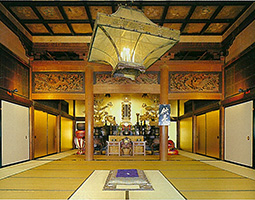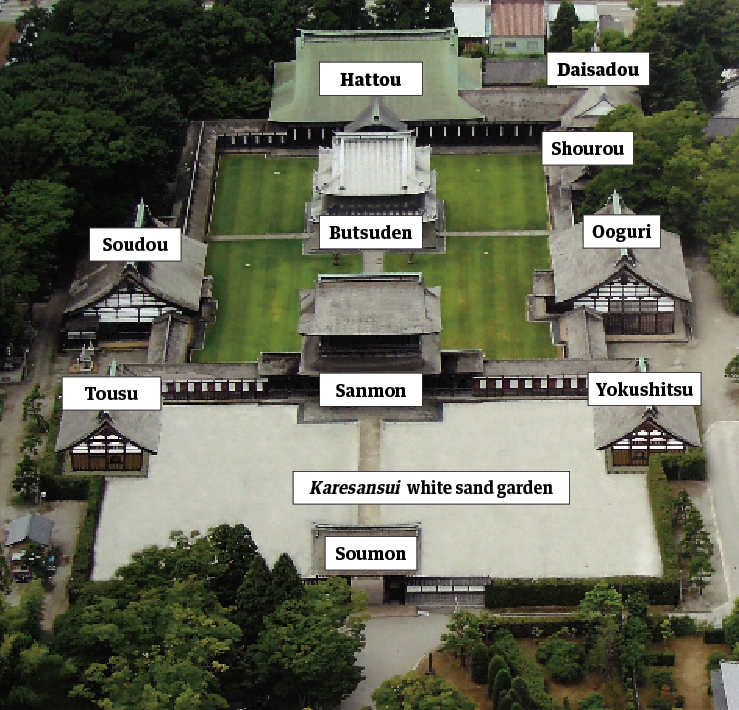
Interior of the Hattou (Dharma hall)
- PREVIOUS
- NEXT
February 2021
A Masterpiece of Zen Temple Architecture

Zuiryuji, located in Takaoka City, Toyama Prefecture, is a magnificent Buddhist temple compound with an ambience of tranquillity created by the neatly ordered layout of its buildings.

Constructed in 1663, Koukouzan Zuiryuji temple (hereafter Zuiryuji) in Takaoka City, Toyama Prefecture is considered a classic example of Zen-style temples of the Edo period (1603–1867). Three buildings in the temple compound are designated as national treasures: the Sanmon (main gate), Butsuden (Buddhist hall) and Hattou (Dharma hall).
Zuiryuji’s most distinctive feature is the layout of the buildings in the temple compound, or garan. The four main buildings, the Soumon gate, the Sanmon gate, Butsuden and Hattou, are laid out in a straight line, and the arrangement is divided into two spaces by the 18-meter-high Sanmon gate. From the Soumon gate to the Sanmon gate, a karesansui (dry landscape) garden of pure white sand creates a tranquil ambience, while beyond the Sanmon up to the Hattou, an expanse of green lawn creates a solemn space for prayer.
The prayer space that begins at the Sanmon is surrounded by a corridor that extends for some 300 meters, connecting the gate to the Hattou in the innermost sanctum. Between the Hattou and the Sanmon stands the Butsuden, which enshrines a statue of the principal image, Shakyamuni Buddha. The symmetrical arrangement of the Soudou (meditation hall) on the left side (southern side) of the corridor and the Ooguri (kitchen) on the right side is characteristic of the Zen architectural style.

Zuiryuji is a bodaiji (family temple), built over a period of twenty years in the mid-seventeenth century by Maeda Toshitsune (1593–1658), third lord of the Kaga domain, as a memorial to his elder brother Maeda Toshinaga (1562–1614), the second lord. Its construction was overseen by Yamagami Zenemon Yoshihiro, the clan’s head carpenter, who was hailed as a master builder. The Butsuden, said to have been Yamagami’s major focus, houses statues of Shakyamuni Buddha, Samantabhadra and Manjushri. The Butsuden is supported at each side by two parallel 13-meter-high, 600-year-old zelkova pillars. This structure allows visitors to enjoy the intricate and elaborate roof ornamentation on the high ceiling, as well as creating a space where the chanting of sutras and the sound of bells resonate together. Another feature of the Butsuden is its lead roof, three millimeters thick and weighing 47 tons. This is said to have been conceived as a resource for making bullets for guns should war ever break out.
“The cost of building Zuiryuji is said to have been so great that it strained the finances of the Kaga Clan. It is testament to the strong respect Toshitsune had for Toshinaga,” says Yotsuya Doukou, head priest of Zuiryuji.
Toshinaga was the founder of Takaoka. In 1609, he built a castle in the wilderness of the Sekino plateau and named the town which grew up around it Takaoka. Toshinaga laid the foundation for commerce and industry in Takaoka. An example is his promotion of the casting industry, which led to casting becoming the local industry of Takaoka. Today, “Takaoka copperware” continues to be known throughout Japan. Interestingly, the roof of the Hattou at Zuiryuji, made from hinoki cypress wood, is in fact thatched with copper. In the center is enshrined an enormous memorial tablet of Toshinaga.
Yotsuya says, “The temple not only displays the aesthetic sense and financial power of the Kaga clan, but also expresses respect for Toshinaga and the feelings of the Maeda family.”
The aura of solemnity created by the orderly layout of the buildings, the simplicity and strength of the Zen architectural style, and the beauty of the details make even non-Buddhists want to quietly surrender themselves to the temple that is Zuiryuji.

- PREVIOUS
- NEXT

